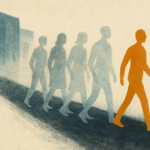How to humanize your business as you digitize it

The heat is on. The pandemic years have precipitated a massive acceleration in all things digital. We know the world revved forward right under our feet. We know we are all doing things that seemed alien to many in 2019: buying much more stuff online; making our homes entertainment hubs; holding remote meetings; using online team collaboration tools. We know that tech companies saw their valuations rocket to sky-high levels during COVID-19.
We look around and see that our competitors are racing ahead with digital initiatives—to reach customers in new ways, and to achieve dramatic efficiencies in work and delivery. We feel the pressure to make a massive push in digital acceleration ourselves.
I have been present in many sessions of late where senior business leaders discuss these digital accelerations. I thought I should share some of the thinking here, because it deserves a wider airing.
My mantra in gatherings to discuss matter digital is always the same: humanize as you digitize. You may have seen those words on this page often. But what do they mean, and how do you do it?
The point is simple: you don’t go digital without thinking about the people around the new digital—the customers and employees. Digital initiatives are primarily focused on customer benefit; and they are delivered by employees, who must also feel the benefit. If your new digital platforms are not embraced by those two groups of people, you will encounter massive resistance and friction. A bit of human-centred thinking upfront will help you avoid that.
Don’t roll out technological initiatives as IT projects; roll them out as human projects. Managing the emotions around technological change matters as much as managing the server farms, security protocols and code.
Perhaps you have an initiative in mind. Omnichannel is big buzzword these days; we can run with that by way of example. Let’s say you want to introduce new digital channels alongside your current ones, to sell to and serve better and to expand your reach. This might involve upgrading your web presence, raising your Insta and TikTok game, or creating a smartphone-centered customer transactions portal if you are in the B2B (business to business) game.
This is how the “humanize” part kicks in. Before you do anything, sit down and map out the human implications of the new tech. Firstly, how will customers benefit? Will they feel the need to change, or will they resist? How will you manage their expectations, hold their hands, train them in the new ways? Think about the benefits, and create a compelling narrative around it. Will customers save time or money? Will they get a better, more personal experience? Or will they just encounter delays and frustrations as they are forcibly migrated to a new system?
Next, think about employees. Will they want this, or will they hate it? Will they feel hope, or fear? Will they come on board quickly to learn and deploy, or will they passive-aggressively resist the change? Who will revel in the new tech, and who will be its victims? What new skillsets will be needed, and how will you develop them?
Lastly, what are the implications for organizational culture? Do these new ways of working lead to impacts on behavioural norms? Which part of culture do we want to shake up or discard, and what should be protected?
Intelligent leaders do not do tech in isolation; they run tech projects as human accelerations, not just digital ones. They manage customer and employee sentiment very carefully even as they introduce dramatically different ways of working. They ensure that they begin with the WHY of the change, not just the who-what-how-where details. They sell the change first, by creating a coalition of the willing.
The rest plunge in with detailed project plans and charts, as though changing a human organization can be run as an engineering project. They ignore sentiment, find it irrelevant, and trample all over it. They value secrecy over participation. And then they find themselves mired in a failing project.
No matter how much technology we deploy, we need the buy-in of humans. Humans will need to plan and deliver the change; humans will need to receive its benefits; humans will need to work in new ways. So if you don’t know how to deal with humans, you don’t know how to introduce any meaningful change.
Feelings. Those old-fashioned things we had, long before we had smartphones. They still drive behaviour. They spur us on to participate; or make us wallow in lethargy. They make us embrace change; or recoil in uncertainty. Are feelings part of your project plan?
(Sunday Nation, 6 March 2022)

Buy Sunny Bindra's new book
The X in CX
here »
Popular Posts
- Keep you, youAugust 17, 2025
- Some lives are lived on the peripheryAugust 3, 2025
- The grace of the giverJuly 27, 2025
- We’re letting the bad drive out the goodJuly 20, 2025















